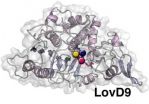(Press-News.org) When a massive star collapses under its own gravity during a supernova explosion it forms either a neutron star or black hole. Magnetars are an unusual and very exotic form of neutron star. Like all of these strange objects they are tiny and extraordinarily dense — a teaspoon of neutron star material would have a mass of about a billion tonnes — but they also have extremely powerful magnetic fields. Magnetar surfaces release vast quantities of gamma rays when they undergo a sudden adjustment known as a starquake as a result of the huge stresses in their crusts.
The Westerlund 1 star cluster [1], located 16 000 light-years away in the southern constellation of Ara (the Altar), hosts one of the two dozen magnetars known in the Milky Way. It is called CXOU J164710.2-455216 and it has greatly puzzled astronomers.
"In our earlier work (eso1034 - http://www.eso.org/public/news/eso1034/) we showed that the magnetar in the cluster Westerlund 1 (eso0510 - http://www.eso.org/public/news/eso0510/) must have been born in the explosive death of a star about 40 times as massive as the Sun. But this presents its own problem, since stars this massive are expected to collapse to form black holes after their deaths, not neutron stars. We did not understand how it could have become a magnetar," says Simon Clark, lead author of the paper reporting these results.
Astronomers proposed a solution to this mystery. They suggested that the magnetar formed through the interactions of two very massive stars orbiting one another in a binary system so compact that it would fit within the orbit of the Earth around the Sun. But, up to now, no companion star was detected at the location of the magnetar in Westerlund 1, so astronomers used the VLT to search for it in other parts of the cluster. They hunted for runaway stars — objects escaping the cluster at high velocities — that might have been kicked out of orbit by the supernova explosion that formed the magnetar. One star, known as Westerlund 1-5 [2], was found to be doing just that.
"Not only does this star have the high velocity expected if it is recoiling from a supernova explosion, but the combination of its low mass, high luminosity and carbon-rich composition appear impossible to replicate in a single star — a smoking gun that shows it must have originally formed with a binary companion," adds Ben Ritchie (Open University), a co-author on the new paper.
This discovery allowed the astronomers to reconstruct the stellar life story that permitted the magnetar to form, in place of the expected black hole [3]. In the first stage of this process, the more massive star of the pair begins to run out of fuel, transferring its outer layers to its less massive companion — which is destined to become the magnetar — causing it to rotate more and more quickly. This rapid rotation appears to be the essential ingredient in the formation of the magnetar's ultra-strong magnetic field.
In the second stage, as a result of this mass transfer, the companion itself becomes so massive that it in turn sheds a large amount of its recently gained mass. Much of this mass is lost but some is passed back to the original star that we still see shining today as Westerlund 1-5.
"It is this process of swapping material that has imparted the unique chemical signature to Westerlund 1-5 and allowed the mass of its companion to shrink to low enough levels that a magnetar was born instead of a black hole — a game of stellar pass-the-parcel with cosmic consequences!" concludes team member Francisco Najarro (Centro de Astrobiología, Spain).
It seems that being a component of a double star may therefore be an essential ingredient in the recipe for forming a magnetar. The rapid rotation created by mass transfer between the two stars appears necessary to generate the ultra-strong magnetic field and then a second mass transfer phase allows the magnetar-to-be to slim down sufficiently so that it does not collapse into a black hole at the moment of its death.
INFORMATION:
Notes
[1] The open cluster Westerlund 1 was discovered in 1961 from Australia by Swedish astronomer Bengt Westerlund, who later moved from there to become ESO Director in Chile (1970). This cluster is behind a huge interstellar cloud of gas and dust, which blocks most of its visible light. The dimming factor is more than 100 000, and this is why it has taken so long to uncover the true nature of this particular cluster.
Westerlund 1 is a unique natural laboratory for the study of extreme stellar physics, helping astronomers to find out how the most massive stars in the Milky Way live and die. From their observations, the astronomers conclude that this extreme cluster most probably contains no less than 100 000 times the mass of the Sun, and all of its stars are located within a region less than 6 light-years across. Westerlund 1 thus appears to be the most massive compact young cluster yet identified in the Milky Way galaxy.
All the stars so far analysed in Westerlund 1 have masses at least 30 times that of the Sun. Because such stars have a rather short life — astronomically speaking — Westerlund 1 must be very young. The astronomers determine an age somewhere between 3.5 and 5 million years. So, Westerlund 1 is clearly a newborn cluster in our galaxy.
[2] The full designation for this star is Cl-Westerlund 1 W 5.
[3] As stars age, their nuclear reactions change their chemical make-up — elements that fuel the reactions are depleted and the products ofthe reactions accumulate. This stellar chemical fingerprint is first rich in hydrogen and nitrogen but poor in carbon and it is only very late in the lives of stars that carbon increases, by which point hydrogen and nitrogen will be severely reduced — it is thought to be impossible for single stars to be simultaneously rich in hydrogen, nitrogen and carbon, as Westerlund 1-5 is.
More information
The research presented in this ESO Press Release will soon appear in the research journal Astronomy and Astrophysics ("A VLT/FLAMES survey for massive binaries in Westerlund 1: IV.Wd1-5 binary product and a pre-supernova companion for the magnetar CXOU J1647-45" by J. S. Clark et al.). The same team published a first study of this object in 2006 ("A Neutron Star with a Massive Progenitor in Westerlund 1"by M. P. Muno et al., Astrophysical Journal, 636, L41).
The team is composed of Simon Clark and Ben Ritchie (The Open University, UK), Francisco Najarro (Centro de Astrobiología, Spain), Norbert Langer (Universität Bonn, Germany, and Universiteit Utrecht, the Netherlands) and Ignacio Negueruela (Universidad de Alicante, Spain).
The astronomers used the FLAMES instrument on ESO's Very Large Telescope at Paranal, Chile to study the stars in the Westerlund 1 cluster.
ESO is the foremost intergovernmental astronomy organisation in Europe and the world's most productive ground-based astronomical observatory by far. It is supported by 15 countries: Austria, Belgium, Brazil, the Czech Republic, Denmark, France, Finland, Germany, Italy, the Netherlands, Portugal, Spain, Sweden, Switzerland and the United Kingdom. ESO carries out an ambitious programme focused on the design, construction and operation of powerful ground-based observing facilities enabling astronomers to make important scientific discoveries. ESO also plays a leading role in promoting and organising cooperation in astronomical research. ESO operates three unique world-class observing sites in Chile: La Silla, Paranal and Chajnantor. At Paranal, ESO operates the Very Large Telescope, the world's most advanced visible-light astronomical observatory and two survey telescopes. VISTA works in the infrared and is the world's largest survey telescope and the VLT Survey Telescope is the largest telescope designed to exclusively survey the skies in visible light. ESO is the European partner of a revolutionary astronomical telescope ALMA, the largest astronomical project in existence. ESO is currently planning the 39-metre European Extremely Large optical/near-infrared Telescope, the E-ELT, which will become "the world's biggest eye on the sky".
Links
[Research paper] - http://www.eso.org/public/archives/releases/sciencepapers/eso1415/eso1415a.pdf
[Photos of the VLT] - http://www.eso.org/public/images/archive/category/paranal/
Contacts
Simon Clark
The Open University
Milton Keynes, United Kingdom
Tel: +44 207 679 4372
Email: jsc@star.ucl.ac.uk
Richard Hook
ESO, La Silla, Paranal and E-ELT Press Officer
Garching bei München, Germany
Tel: +49 89 3200 6655
Email: rhook@eso.org
Magnetar formation mystery solved?
2014-05-14
ELSE PRESS RELEASES FROM THIS DATE:
Microchip-like technology allows single-cell analysis
2014-05-14
VIDEO:
This is a microscopic view of the new microchip-like technology sorting and storing magnetic particles in a three-by-three array.
Click here for more information.
DURHAM, N.C. -- A U.S. and Korean research team has developed a chip-like device that could be scaled up to sort and store hundreds of thousands of individual living cells in a matter of minutes. The system is similar to a random access memory chip, but it moves cells rather than electrons.
Researchers at ...
Using nature as a model for low-friction bearings
2014-05-14
Lubricants are required wherever moving parts come together. They prevent direct contact between solid elements and ensure that gears, bearings, and valves work as smoothly as possible. Depending on the application, the ideal lubricant must meet conflicting requirements. On the one hand, it should be as thin as possible because this reduces friction. On the other hand, it should be viscous enough that the lubricant stays in the contact gap. In practice, grease and oils are often used because their viscosity increases with pressure.
Biological lubrication in contrast is ...
Early menopause ups heart failure risk, especially for smokers
2014-05-14
CLEVELAND, Ohio (May 14, 2014)—Women who go through menopause early—at ages 40 to 45—have a higher rate of heart failure, according to a new study published online today in Menopause, the journal of The North American Menopause Society (NAMS). Smoking, current or past, raises the rate even more.
Research already pointed to a relationship between early menopause and heart disease—usually atherosclerotic heart disease. But this study from the Karolinska Institute in Stockholm, Sweden, is the first to demonstrate a link with heart failure, the inability of the heart to pump ...
Virginia Tech updates football helmet ratings, 5 new helmets meet 5-star mark
2014-05-14
Virginia Tech has updated results of its adult football helmet ratings, which are designed to identify key differences between the abilities of individual helmets to reduce the risk of concussion.
All five of the new adult football helmets introduced this spring earned the five-star mark, which is the highest rating awarded by the Virginia Tech Helmet Ratings™. The complete ratings of the helmets manufactured by Schutt Sports and Xentih LLC, each with two new products, and Rawlings Sporting Goods Co., with one helmet, are publicly available at the helmet ratings website.
The ...
Primates and patience -- the evolutionary roots of self control
2014-05-14
Lincoln, Neb., May 14, 2014 – A chimpanzee will wait more than two minutes to eat six grapes, but a black lemur would rather eat two grapes now than wait any longer than 15 seconds for a bigger serving.
It's an echo of the dilemma human beings face with a long line at a posh restaurant. How long are they willing to wait for the five-star meal? Or do they head to a greasy spoon to eat sooner?
A paper published today in the scientific journal Proceedings of the Royal Society B explores the evolutionary reasons why some primate species wait for a ...
Human learning altered by electrical stimulation of dopamine neurons
2014-05-14
PHILADELPHIA - Stimulation of a certain population of neurons within the brain can alter the learning process, according to a team of neuroscientists and neurosurgeons at the University of Pennsylvania. A report in the Journal of Neuroscience describes for the first time that human learning can be modified by stimulation of dopamine-containing neurons in a deep brain structure known as the substantia nigra. Researchers suggest that the stimulation may have altered learning by biasing individuals to repeat physical actions that resulted in reward.
"Stimulating the substantia ...
Hospital rankings for heart failure readmissions unaffected by patient's socioeconomic status
2014-05-13
A new report by Icahn School of Medicine at Mount Sinai, published in the journal Circulation: Cardiovascular Quality and Outcomes, shows the socioeconomic status of congestive heart failure patients does not influence hospital rankings for heart failure readmissions.
In the study, researchers assessed whether adding a standard measure for indicating the socioeconomic status of heart failure patients could alter the expected 30-day heart failure hospital risk standardized readmission rate (RSRR) among New York City hospitals. For each patient a standard socioeconomic ...
Medications can help adults with alcohol use disorders reduce drinking
2014-05-13
Several medications can help people with alcohol use disorders maintain abstinence or reduce drinking, according to research from the University of North Carolina at Chapel Hill.
The work, published today in the Journal of the American Medical Association (JAMA) and funded by the Agency for Healthcare Research and Quality (AHRQ), provides additional options for clinicians to effectively address this global concern.
Although alcohol use disorders are associated with many health problems, including cancers, stroke and depression, fewer than one-third of people with the ...
Clean air in Iowa
2014-05-13
With warmer weather, it's time to get outdoors. And now you can breathe easy about it: A new study from the University of Iowa reports Iowa's air quality falls within government guidelines for cleanliness.
The UI researchers analyzed air quality and pollution data compiled by state and county agencies over nearly three years at five sites spread statewide—urban areas Cedar Rapids, Davenport and Des Moines and rural locations in Montgomery county in southwest Iowa and Van Buren county in the southeast. The result: The air, as measured by a class of fine particulate pollutants ...
Scientists reveal structural secrets of enzyme used to make popular anti-cholesterol drug
2014-05-13
In pharmaceutical production, identifying enzyme catalysts that help improve the speed and efficiency of the process can be a major boon. Figuring out exactly why a particular enzyme works so well is an altogether different quest.
Take the cholesterol-lowering drug simvastatin. First marketed commercially as Zocor, the statin drug has generated billions of dollars in annual sales. In 2011, UCLA scientists and colleagues discovered that a mutated enzyme could help produce the much sought-after pharmaceutical far more efficiently than the chemical process that had been ...







